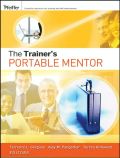
This important resource offers proven guidelines and techniques for success in the core components of training and development, real-world case studies, ready-to-use tools written by the worlds best trainers. The information is presented in a collection of short articles and is well indexed for fast retrieval.The articles are organized around major topics and include supporting case studies, self-assessment, interactive reader simulations, and supplemental tools. INDICE: Website Contents. Introduction. SECTION 1: DESIGNING TRAINING. Introduction to Section 1: Designing Training. Article 1: Avoiding Biased Questions for Training Needs Assessments (Grace Ann Rosile, Ph.D.). Article 2: Taxonomy of Learning Designs (David D. Weiss, Ph. D.). Article 3: Designing Instructional Strategies: A Cognitive Perspective (Kenneth H. Silber, Ph.D., and Wellesley R. Foshay, Ph.D., CPT). Article 4: Dont Be an Order Taker (Jane Bozarth).Article 5: Never Lose Sight of Your Audience (Jean Marrapodi). Article 6: If You Dont Know Where You Are Going, You Will Probably End Up Somewhere Else (Toni Hodges DeTuncq). Article 7: ISD-Faster, Better, Easier (Daryl L. Sink, Ed. D.). Article 8: Front-End Analysis, Implementation Planning, and Evaluation: Escaping the Pamela Syndrome (Harold D. Stolovitch). Article 9: Creativity, Emergence, and Designing the Learning Experience (S Peter C. Honebein, Ph.D.). Article 10: Creating Sacred Space (Michael Milano). Article 11: e-Learning Content-Sorting Through the Tonnage: A Quick Anatomy Lesson for Those on the ‘Buy’ Side (Steve D. Bordonaro and Frank P. Bordonaro). Article 12: Blended LearningStrategies for Knowledge Workers That Work (Deborah Stone, Steve Villachica, Ph.D., and John Endicott). Article 13: Confessions of a Gamer: I See Games (Steve Sugar). Conclusion to Section 1. SECTION 2: DELIVERING TRAINING. Introduction to Section 2: Delivering Training. Article 14: Make Adult Learning Come toLife (Jean Barbazette). Article 15: Making Workshops Work: Lessons from an Old Pro (Hal Kane, Ph.D.). Article 16: Incredible Credibility (Terrence L. Gargiulo). Article 17: Enlarge the Pool of Participant at the Beginning of Any Training Event (Mel Silberman). Article 18: How Learners Are Motivated (Matthew S.Richter). Article 19: Applying Self-Determination to Training ( Matthew S. Richter). Article 20: The Best Training I Never Did (Glenn Smeaton). Article 21:Some Basics from a Couple of Training Pros: Training Is More Than What You Say (Terrence L. Gargiulo and Robb Murray). Article 22: The Synergy of Co-Facilitation: Creating Powerful Learning Experiences (Dr. Vince Molinaro). Article 23: Learnertainment (Lenn Millbower). Article 24: Seven Strategies on How to Use Stories to Increase Learning and Facilitate Training (Terrence L. Gargiulo).Article 25: Dealing with Difficult Issues in Training (Terrence L. Gargiulo).Conclusion to Section 2. SECTION 3: WORKFORCE PERFORMANCE AND LEARNING. Introduction to Section 3: Workforce Performance and Learning. Article 26: Capturing Learning Opportunities Within Your Organization (Ajay M. Pangarkar and Teresa Kirkwood). Article 27: New Accountabilities: Non-Financial Measures of Performance (Ajay M. Pangarkar and Teresa Kirkwood). Article 28: Discovery Learning: The Driving Force Behind Achieving Real Organizational Change ( Catherine J.Rezak). Article 29: The Integrated Approach to Leadership Development (Dr. Vince Molinaro and Dr. David Weiss). Article 30: Independent Means: Taking Control of Internal Knowledge and Minimizing Dependency on External Expertise (AjayM. Pangarkar and Teresa Kirkwood). Article 31: Return on Intelligence: The New ROI (Ann Herrmann-Nehdi). Article 32: Turnover-Slaying the Monster One Touchat a Time (Dr. Frank P. Bordonaro). Article 33: Creating Credibility with Senior Management: A Simple Approach for Connecting Training to the Business (Timothy P. Mooney and Robert O. Brinkerhoff, Ed.D.). Article: 34: Workplace Learning-Beyond the Classroom (Ajay M. Pangarkar and Teresa Kirkwood). Article 35: A Business Approach to Learning: Increasing Profits Through Marketing Methodologies (Ajay M. Pangarkar and Teresa Kirkwood)Conclusion to Section 3. SECTION 4: MEASUREMENT and EVALUATION. Introduction to Section 4: Measurement and Evaluation. Article 36: Beyond ROI: To Boldly Go Where No Training Evaluation Has Gone Before (Ajay M. Pangarkar and Teresa Kirkwood). Article 37: Linking Learning Strategy to the Balanced Score Card (Ajay M. Pangarkar and Teresa Kirkwood). Article 38: Taking a Strategic Approach to Evaluation: Proving and Improving the Value of Training (Tim Mooney and Robert Brinkeroff). Article 39: Measure and Optimize Trainings Impact (W. Boyce Byerly). Article 40: Formative Evaluation: Getting It Right the First Time (Donald L. Kirkey and Gary A. DePaul). Article 41: Measuring the Impact of Leadership: Fact or Fiction? (Ajay M. Pangarkar and Teresa Kirkwood). Article 42: Transition Planning Steps for Buildingand Sustaining a Results-Based Learning Focus (Holly Burkett). Article 43: Demonstrating Your Worth to Management with Credible (Business-Focused Results (Harold D. Stolovitch and Paul Flynn). Article 44: We Know We Got There (Toni Hodges DeTuncq). Article 45: A Four-Part Strategy for Communicating Business Value (Theresa Seagraves). Article 46: Measuring Time to Proficiency (Steven C. Rosenbaum). Article 47: Making ‘Cents’ from Your Training ROI: How Organizations Can Make Training Accountable (Ajay M. Pangarkar and Teresa Kirkwood). Conclusion to Section 4. SECTION 5: PROFESSIONAL DEVELOPMENT. Introduction to Section 5: Professional Development. Article 48: What Makes a Good Trainer and Facilitator (Tom Short). Article 49: Lifelong Learning (Elaine Beich). Article 50: Learn to Communicate in Business-Speak (Ajay M. Pangarkar and Teresa Kirkwood). Article 51: The Trainer as a CAPABLE Leader (Dr. Vince Molinaro and Dr. David Weiss). Article 52: Trusting Relationships in Learning (Dr. David S. Weiss). Article 53: The Need for Personal Vision (K. Jayshankar). Article 54: Ten Strategies for Building Successful Partnerships (Terrence L. Garguilo). Article55: Developmental Assignments (Cynthia D. McCauley). Article 56: Dont Fight the Future (Jane Bozarth). Article 57: Five Ideas on How to Take Charge of YourRecharging (Terrence L. Gargiulo). Conclusion to Section 5. Whos Who in Training and Development. The Editors. The Contributors. Index. How to Use the Pfeiffer Website.
- ISBN: 978-0-7879-9428-0
- Editorial: Jossey Bass
- Encuadernacion: Rústica
- Páginas: 688
- Fecha Publicación: 11/06/2008
- Nº Volúmenes: 1
- Idioma: Inglés
